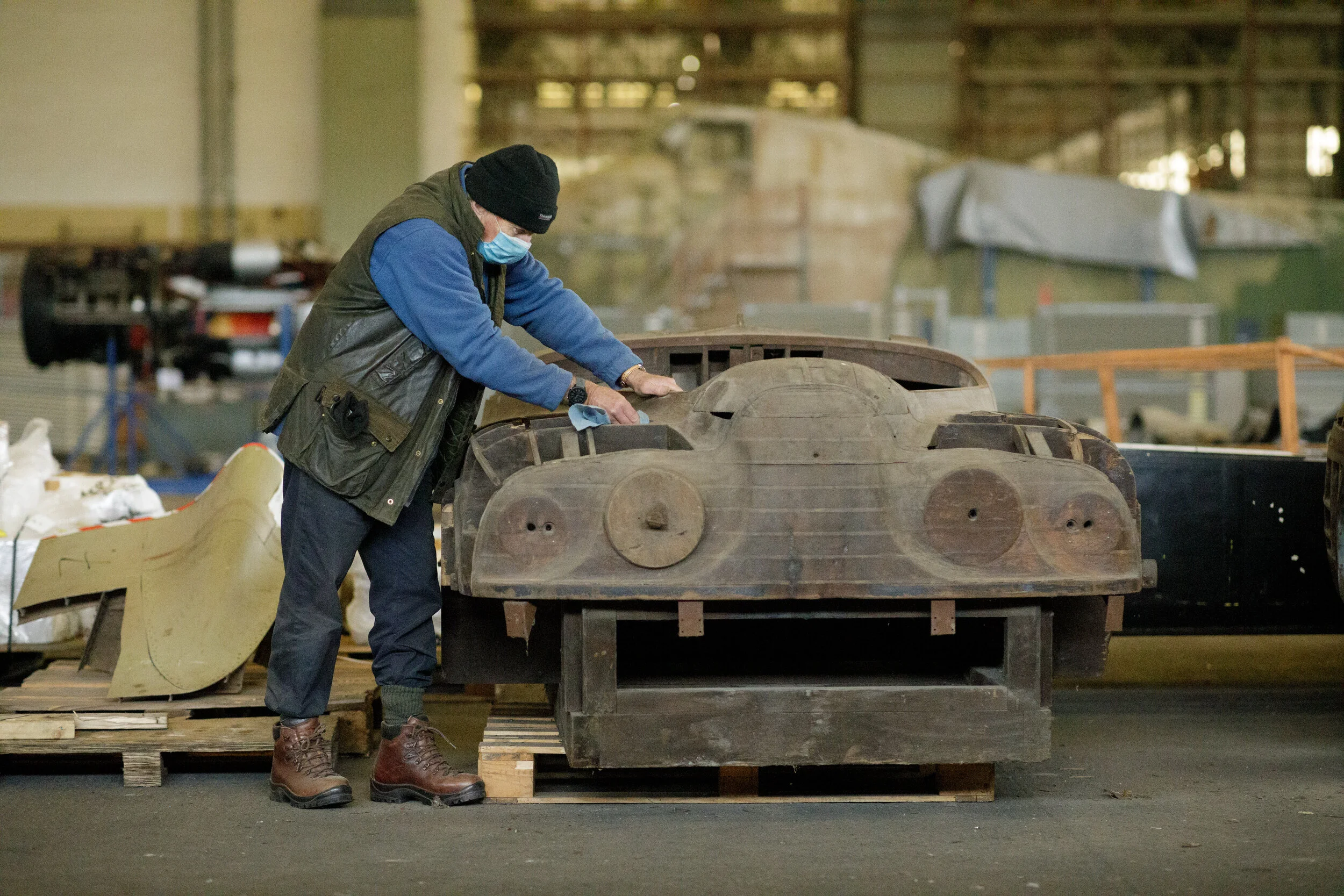Bucks in the Brabazon Hangar
By Stefan Cembrowicz. Photographs by Sam Frost.
Not everybody knows that radical, high performance cars were once built in Bristol. During 1942, the darkest year of the war, Bristol Aeroplane Co MD Sir George White realised that, with a specialised aeroengineering workforce of up to 70,000 in the Filton works, when victory came he would need to diversify to avoid casting large numbers of skilled aircraft workers into redundancy. This had happened in 1918 when all armament orders for the Bristol Fighter were cancelled overnight.
As one example of this diversification, in 1946 the Bristol Aeroplane Company formed a Car Division.
Sir George’s vision was that an existing marque such as Aston Martin would be acquired, to be developed as a starter model enabling Bristol to set up its own design, manufacturing, and distribution systems. Bristol cars were to be built in-house by aircraft designers and engineers, within the aeroplane factory works. Production numbers and quality to rival, say, Bentley were contemplated.
Initially, rather than Aston Martin, features of a pre-war sports racing BMW (the 328) and its 326 and 327 siblings were used under an existing prewar licence with AFN as the design basis for the first Bristol car, the Type 400.
With its high-performance six cylinder 2 litre engine, the BMW came with a fine history of prewar and wartime sporting victories such as the Mille Miglia. A workforce of around 300 was initially employed on the Car Division project, with 30 in the design and drawing office alone.
But using years of wartime experience in metallurgy, evolving new materials, and the latest aero-engineering wind tunnel technology, the Car Division soon developed its own more advanced models. Italian coachbuilder Touring Milano inspired the second model of the range, the super-streamlined aluminium bodied Bristol 401; with its high efficiency engine and low frontal drag, this was surely the most advanced British car of its era. Radical “Aerodyne” models evolved rapidly through the early 1950s, thanks to seemingly limitless funding from the parent BAC. Types 403,404, 405 and 406, each unique, were built to the most exacting aircraft standards. A composite bodied, gas turbine driven 4wd streamliner was even considered in 1951!
Competition and racing successes soon followed. The 2 litre engine was breathed on by Filton’s technicians - by the mid 1950s racing models were developing 150bhp, twice the BMW’s original 75bhp.
To quote one competitor “anybody who was anybody in the racing world used the Bristol 2 litre engine”. Bristol-powered marques such as Cooper Bristol, Frazer Nash, and Lister-Bristol battled it out on the international circuits. And Bristol’s own long-distance racing model, the Type 450 was hugely successful, with wins at Le Mans and Rheims.
Production numbers were always small - only up to 4 or 5 per week, with cars finished to the highest standards - scrutinised by aero industry standard inspectors. And prices to match, inflated by the Governments 100% car tax.
But by the 1960s 2 litre engines, however highly tuned, were just not enough to compete with much cheaper 3.8 litre Jaguars (at half the price!) and heavier 4 litre Aston Martins. And parent company funding for a Bristol designed aluminium 3.6 litre engine, in a radical rubber suspended magnesium chassis, suddenly dried up, as the UK’s entire aeroplane industry faced financial challenges of metal fatigue crashes.
A 5.2 litre Canadian Chrysler V8 was imported by Bristol to replace its venerable 6 cylinder unit, and even larger versions of this smooth and powerful V8 were to be used for the next 40 years.
By the 1970s, radical designs had become quietly conservative, and the 1940s “Fighter Pilot’s Delight” became the 1980s “Businessman’s Express”. Model after model followed the 407 V8, with an Italian Zagato-styled 412 - and even a turbocharged Beaufighter model. Coachwork became discreetly anonymous, a Savile Row suit covering Canadian muscle and British craftsmanship.
A 2 seater 8 litre V10 was designed and produced in the early 2000s, but alas this was the company’s swansong, with only 10 made and perhaps 9 more unfinished. And a brief rebirth in 2011 failed last year. Just one model was proposed, a 2 seater on a Morgan chassis, which never went into production.
Will Bristol cars rise from the ashes with new funds and a 21C product?
The Bristol Owners Heritage Trust , a small enthusiast-run charity, crowdfunded enough money to salvage the original wooden coachbuilder’s bucks, upon which every 2 litre and V8 Bristol was hand built. Press-ganged volunteers convoyed them up the M4 to Filton, mercifully without mishap.
Thanks to kind help from Aerospace Bristol , the bucks are temporarily stored near their birthplace, in the marvellous Brabazon Hangar.
They are almost unique examples of craftsman’s work, their industrial and social history bearing the marks of work of some of Bristol’s finest artisans. They illustrate the crossover of traditional skills from the carpentry that built the box kite and Bristol Fighter into streamlined aero technology. They include the actual buck upon which the 403 car now on display in Aerospace Bristol was built, nearly 60 years ago. Cars will never be handbuilt in this way again.
The Bristol Owners Heritage Trust are finding appropriate museum homes for them.
The Bristol Industrial Museum are among those receiving a buck, as are the National Motor Museum at Gaydon, the Science Museum, and the local Atwell-Wilson Museum at Calne. For more details, please see bristolownersht.com
Photography by Sam Frost






















